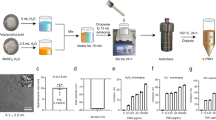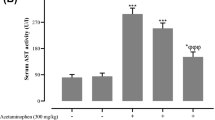ABSTRACT
Purpose
Paracetamol (acetaminophen, APAP) overdose is often fatal due to progressive and irreversible hepatic necrosis. The aim of this work was to design Andrographolide (AG) loaded nanoparticles to prevent similar hepatic necrosis.
Methods
Functionalized AG-loaded PLGA nanoparticles carrying different densities of heparin were prepared following a facile emulsion solvent evaporation technique. Nanoparticle morphology, loading and release kinetics were studied. Hepatic localization of the nanoparticles was investigated in both normal and APAP damaged conditions using FITC fluorescent probe. Different serum parameters and liver histopathology were further examined as indicators of hepatic condition before and after treatment.
Result
A collection of heparin functionalized AG-loaded PLGA nanoparticles were designed. Low amount of heparin on the particle surface could rapidly localize the nanoparticles up to the liver. The new functionalized AG nanoparticles affect efficient hepatoprotection in experimental mouse APAP overdose conditions. AG nanoparticle hepatoprotection was due to the rapid regeneration of antioxidant capacity and hepatic GSH store.
Conclusions
Engineered nanoparticles loaded with AG provided a fast protection in APAP induced acute liver failure.










Similar content being viewed by others

Abbreviations
- AG:
-
andrographolide
- AGnp:
-
andrographolide nanoparticle
- APAP:
-
N-acetyl-p-aminophenol
- BCS:
-
biopharmaceutical classification system
- CT:
-
computed tomography
- CTCF:
-
corrected total cell fluorescence
- DILD:
-
drug induced liver damage
- FITC:
-
fluorescein isothiocyanate
- Fnp:
-
fluorescent nanoparticle
- Hep:
-
heparin
- Hep-Fnp:
-
heparinized fluorescent nanoparticle
- Hep-AGnp:
-
heparin functionalized andrographolide nanoparticle
- KCE:
-
known chemical entity
- MDA:
-
malondialdehyde
- Mrp:
-
multi-drug resistance protein
- NAC:
-
N-acetyl cysteine
- NAPQI:
-
N-acetyl-para benzoquinoneimine
- PEO:
-
polyethylene oxide
- PLGA:
-
poly (D-L-lactide-co-glycolic acid)
- PPO:
-
polypropylene oxide
- ROS:
-
reactive oxygen species
REFERENCES
Lee WM. Acetaminophen-related acute liver failure in the United States. Hepatol Res. 2008;38(Suppl1):S3–8.
Knight TR, Fariss MW, Farhood A, Jaeschke H. Role of lipid peroxidation as a mechanism of liver injury after acetaminophen overdose in mice. Toxicol Sci. 2003;76(1):229–36.
Chen C, Hennig GE, Manautou JE. Hepatobiliary excretion of acetaminophen glutathione conjugate and its derivatives in transport-deficient (TR-) hyperbilirubinemic rats. Drug Metab Dispos. 2003;31(6):798–804.
Knight TR, Kurtz A, Bajt ML, Hinson JA, Jaeschke H. Vascular and hepatocellular peroxynitrite formation during acetaminophen toxicity: role of mitochondrial oxidant stress. Toxicol Sci. 2001;62(2):212–20.
Jaeschke H, McGill MR, Williams CD, Ramachandran A. Current issues with acetaminophen hepatotoxicity—a clinically relevant model to test the efficacy of natural products. Life Sci. 2011;88(17–18):737–45.
North TE, Babu IR, Vedder LM, Lord AM, Wishnok JS, Tannenbaum SR, et al. PGE2-regulated wnt signaling and N-acetylcysteine are synergistically hepatoprotective in zebrafish acetaminophen injury. Proc Natl Acad Sci U S A. 2010;107(40):17315–20.
Hidalgo MA, Romero A, Figueroa J, Cortes P, Concha II, Hancke JL, et al. Andrographolide interferes with binding of nuclear factor-kappaB to DNA in HL-60-derived neutrophilic cells. Br J Pharmacol. 2005;144(5):680–6.
Trivedi NP, Rawal UM, Patel BP. Hepatoprotective effect of andrographolide against hexachlorocyclohexane-induced oxidative injury. Integr Cancer Ther. 2007;6(3):271–80.
Sheeja K, Guruvayoorappan C, Kuttan G. Antiangiogenic activity of Andrographis paniculata extract and andrographolide. Int Immunopharmacol. 2007;7(2):211–21.
Zhu SP, Kang BA. Distribution and excretion of [35S] NaHSO3-andrographolide by autoradiography. Acta Pharmacol Sin. 1981;2(4):266–9.
Yuasa H, Watanabe J. Are novel scavenger-like receptors involved in the hepatic uptake of heparin? Drug Metab Pharmacokinet. 2003;18(5):273–86.
Sun IC, Eun DK, Na JH, Lee S, Kim IJ, Youn IC, et al. Heparin-coated gold nanoparticles for liver-specific CT imaging. Chemistry. 2009;15(48):13341–7.
Park K, Kim K, Kwon IC, Kim SK, Lee S, Lee DY, et al. Preparation and characterization of self-assembled nanoparticles of heparin-deoxycholic acid conjugates. Langmuir. 2004;20(26):11726–31.
Roy P, Das S, Bera T, Mondol S, Mukherjee A. Andrographolide nanoparticles in leishmaniasis: characterization and in vitro evaluations. Int J Nanomed. 2010;5:1113–21.
Wirsen A, Ohrlander M, Albertsson AC. Bioactive heparin surfaces from derivatization of polyacrylamide-grafted LLDPE. Biomaterials. 1996;17(19):1881–9.
Mladenovic D, Radosavljevic T, Ninkovic M, Vucevic D, Jesic-Vukicevic R, Todorovic V. Liver antioxidant capacity in the early phase of acute paracetamol-induced liver injury in mice. Food Chem Toxicol. 2009;47(4):866–70.
Ellman GL. Tissue sulfhydryl groups. Arch Biochem Biophys. 1959;82(1):70–7.
Ohkawa H, Ohishi N, Yagi K. Assay for lipid peroxides in animal tissues by thiobarbituric acid reaction. Anal Biochem. 1979;95(2):351–8.
Misra HP, Fridovich I. The generation of superoxide radical during the autoxidation of hemoglobin. J Biol Chem. 1972;247(21):6960–2.
Best TM, Fiebig R, Corr DT, Brickson S, Ji L. Free radical activity, antioxidant enzyme, and glutathione changes with muscle stretch injury in rabbits. J Appl Physiol. 1999;87(1):74–82.
Gavet O, Pines J. Progressive activation of CyclinB1-Cdk1 coordinates entry to mitosis. Dev Cell. 2010;18(4):533–43.
Kemp MM, Kumar A, Mousa S, Dyskin E, Yalcin M, Ajayan P, et al. Gold and silver nanoparticles conjugated with heparin derivative possess anti-angiogenesis properties. Nanotechnology. 2009;20(45):1–7.
Meng ZX, Zheng W, Li L, Zheng YF. Fabrication, characterization and in vitro drug release behavior of electrospun PLGA/chitosan nanofibrous scaffold. Mater Chem Phys. 2011;125(3):606–11.
Innocenzi P, Malfatti L, Piccinini M, Marcelli A. Evaporation-induced crystallization of pluronic F127 studied in situ by time-resolved infrared spectroscopy. J Phys Chem A. 2010;114(1):304–8.
Yuk SH, Oh KS, Cho SH, Kim SY, Oh S, Lee JH, et al. Enhancement of the targeting capabilities of the Paclitaxel-loaded pluronic nanoparticles with a glycol chitosan/heparin composite. Mol Pharm. 2012;9(2):230–6.
Grattard N, Pernin M, Marty B, Roudaut G, Champion D, Le Meste M. Study of release kinetics of small and high molecular weight substances dispersed into spray-dried ethylcellulose microspheres. J Control Release. 2002;84(3):125–35.
Siepmann J, Siepmann F. Mathematical modeling of drug delivery. Int J Pharm. 2008;364(2):328–43.
Lin HR, Sung KC, Vong WJ. In situ gelling of alginate/pluronic solutions for opthalmic delivery of pilocarpine. Biomacromolecules. 2004;5(6):2358–65.
Marschall HU, Wagner M, Zollner G, Trauner M. Clinical hepatotoxicity regulation and treatment with inducers of transport and cofactors. Mol Pharm. 2007;4(6):895–910.
Hinson JA, Roberts DW, James LP. Mechanisms of acetaminophen-induced liver necrosis. In: Uetrecht J, editor. Adverse drug reactions, handbook of experimental pharmacology. Berlin Heidelberg: Springer-Verlag; 2010. p. 369–405.
Ferret PJ, Hammoud R, Tulliez M, Tran A, Trebeden H, Jaffray P, et al. Detoxification of reactive oxygen species by a nonpeptidyl mimic of superoxide dismutase cures acetaminophen-induced acute liver failure in the mouse. Hepatology. 2001;33(5):1173–80.
Jaeschke H, Bajt ML. Intracellular signaling mechanisms of acetaminophen-induced liver cell death. Toxicol Sci. 2006;89(1):31–41.
Visen PKS, Shukla B, Patnaik GK, Dhawan BN. Andrographolide protects rat hepatocytes against paracetamol-induced damage. J Ethnopharmacol. 1993;40(2):131–6.
Shi G, Zhang Z, Zhang R, Zhang X, Lu Y, Yang J, et al. Protective effect of andrographolide against concanavalin A-induced liver injury. Naunyn Schmiedebergs Arch Pharmacol. 2012;385(1):69–79.
Chang KT, Lii CK, Tsai CW, Yang AJ, Chen HW. Modulation of the expression of the pi class of glutathione S-transferase by Andrographis paniculata extracts and andrographolide. Food Chem Toxicol. 2008;46(3):1079–88.
Jarukamjorn K, Don-in K, Makejaruskul C, Laha T, Daodee S, Pearaksa P, et al. Impact of Andrographis paniculata crude extract on mouse hepatic cytochrome P450 enzymes. J Ethnopharmacol. 2006;105(3):464–7.
Dunn SE, Coombes AGA, Garnett MC, Davis SS, Davies MC, Illum L. In vitro cell interaction and in vivo biodistribution of poly(lactide-co-glycolide) nanospheres surface modified by poloxamer and poloxamine copolymers. J Control Release. 1997;44(1):65–76.
Santander-Ortega MJ, Jodar-Reyes AB, Csaba N, Bastos-Gonzalez D, Ortega-Vinuesa JL. Colloidal stability of pluronic F68-coated PLGA nanoparticles: a variety of stabilisation mechanisms. J Colloid Interface Sci. 2006;302(2):522–9.
Oh KS, Song JY, Yoon SJ, Park Y, Kim D, Yuk SH. Temperature-induced gel formation of core/shell nanoparticles for the regeneration of ischemic heart. J Control Release. 2010;146(2):207–11.
Besheer A, Vogel J, Glanz D, Kressler J, Groth T, Mäder K. Characterization of PLGA nanospheres stabilized with amphiphilic polymers: hydrophobically modified hydroxyethyl starch vs pluronics. Mol Pharm. 2009;6(2):407–15.
Fakurazi S, Hairuszah I, Nanthini U. Moringa oleifera Lam prevents acetaminophen induced liver injury through restoration of glutathione level. Food Chem Toxicol. 2008;46(8):2611–5.
Trivedi NP, Rawal UM. Hepatoprotective and antioxidant property of Andrographis paniculata (Nees) in BHC induced liver damage in mice. Indian J Exp Biol. 2001;39(1):41–6.
Hinson JA, Reid AB, McCullough SS, James LP. Acetaminophen-induced hepatotoxicity: role of metabolic activation, reactive oxygen/nitrogen species, and mitochondrial permeability transition. Drug Metab Rev. 2004;36(3–4):805–22.
Mehrab-Mohseni M, Sendi H, Steuerwald N, Ghosh S, Schrum LW, Bonkovsky HL. Legalon-SIL downregulates HCV core and NS5A in human hepatocytes expressing full-length HCV. World J Gastroenterol. 2011;17(13):1694–700.
ACKNOWLEDGMENTS AND DISCLOSURES
Senior Research Fellowships to Partha Roy and Suvadra Das from Indian Council for Medical Research and Council of Scientific and Industrial Research respectively, is gratefully acknowledged. This work is partly funded from the Department of Biotechnology Govt of India nanoscience and nanotechnology grants. Dr. Runa Ghosh Auddy would like to thank CRNN, University of Calcutta for financial assistance.
Author information
Authors and Affiliations
Corresponding author
Rights and permissions
About this article
Cite this article
Roy, P., Das, S., Auddy, R.G. et al. Engineered Andrographolide Nanoparticles Mitigate Paracetamol Hepatotoxicity in Mice. Pharm Res 30, 1252–1262 (2013). https://doi.org/10.1007/s11095-012-0964-5
Received:
Accepted:
Published:
Issue Date:
DOI: https://doi.org/10.1007/s11095-012-0964-5



